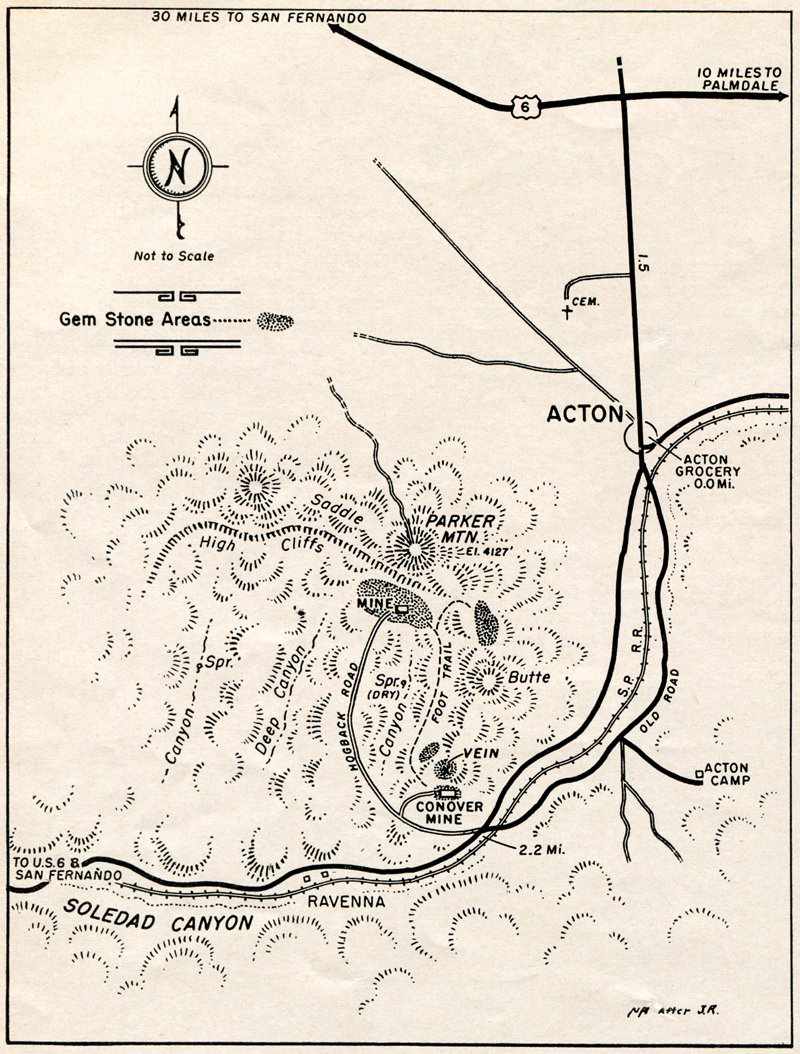|
|
Soledad Canyon

Click image to enlarge Map by Norton Allen, used to illustrate the story, "Green Garden Stone Above Old Ravenna," Desert magazine, February 1957. Shows gemstone quarries above the tiny mining town of Ravenna, four miles southwest of Acton in Soledad Canyon. A number of miners, most notably Colonel Thomas Finley Mitchell, arrived in Soledad Canyon in 1860 and set up various mining camps near the canyon's rich veins of gold, silver and copper, which came into great demand when the Civil War broke out only a year later. Historian Jerry Reynolds writes: "A conglomeration of log cabins and tents moved up and down the canyon with each new strike. Called "Soledad City" wherever it was plunked down, it provided such basic needs as faro tables, rye whiskey, and ladies of the evening. A portable grocery was operated by James O'Reilly, a flaming-haired Irishman of medium build, pug nose, and happy-go-lucky air about him." It wasn't long before a post office was needed, and as one might expect, the U.S. Postal Service rejected the name "Soledad City" out of fear that it would be confused with the city of Soledad in Monterey County. O'Reilly suggested the name "Ravenna," in honor of the local merchant and saloon keeper, Manuel Ravenna. The name became official on June 12, 1868. Ravenna became a shipping point from which the canyon's gold, silver and copper ores were hauled off to San Pedro. The area was also rich in a variety of gemstones, particularly moss agate and green waxy quartz, as evidenced by this map of several old gemstone mines. Strip mining is still a big industry in the Soledad and in parts of the neighboring Mojave Desert, but the little mining camp that was named for its long-forgotten barkeep is little more than a faded memory.
LW2627b: 19200 dpi jpeg from original magazine page purchased 2014 by Leon Worden | Same as AP2904. |
Copper Hill Mining Co. Stock Cert 1863
Occidental Copper Mining Co. Stock Cert 1863
• Minerals of Mint Canyon (Pacific Mineralogist 12/1941)
1966 Rockhounding Guide
Loading Chute
Gemstone Map
Copper Vein
Mine Shaft
|
The site owner makes no assertions as to ownership of any original copyrights to digitized images. However, these images are intended for Personal or Research use only. Any other kind of use, including but not limited to commercial or scholarly publication in any medium or format, public exhibition, or use online or in a web site, may be subject to additional restrictions including but not limited to the copyrights held by parties other than the site owner. USERS ARE SOLELY RESPONSIBLE for determining the existence of such rights and for obtaining any permissions and/or paying associated fees necessary for the proposed use.






